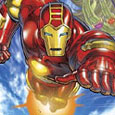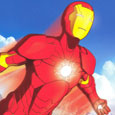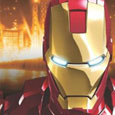Marvel Studios (1994-1996), Walt Disney Studios Home Entertainment (May 4, 2010), 3 discs, 572 mins plus supplements, 1.33:1 original full frame ratio, Dolby Digital 2.0, Rated TV-Y7, Retail: $29.99
Storyboard:
Billionaire industrialist Tony Stark fends off the threat of The Mandarin and an assortment of technological villains, with the help of his super-powered team-mates in Force Works.
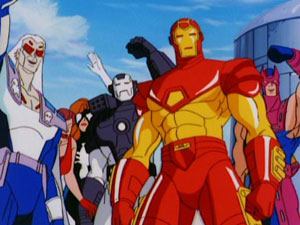
The Sweatbox Review:
The mid-nineties were an interesting time for Marvel superheroes in animation. Fans generally liked the X-Men (1992-97) and Spider-Man (1994-98) shows on Fox Kids, making them huge ratings hits and contributing significantly to those characters’ enduring success in popular culture. On the other hand, there was The Marvel Action Hour, which aired in syndication. This hour combined animated versions of both Fantastic Four (see our review) and Iron Man, with varying success. Each segment has a similar history, with a first season that was ill-conceived, horribly written, and badly designed and animated; followed by a second season that was ever so much better, but probably wasn’t watched by as many fans, who had been burned already by the awful first season. Poor scheduling, declining ratings, and Marvel’s bankruptcy saw the shows end after their second seasons.
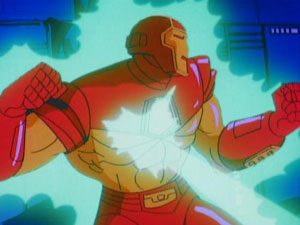
For the character of Iron Man, it was his second show as the star, succeeding the cheesy 1960s Marvel Super Heroes show, in which he rotated segments with other characters, with each segment barely being animated by essentially sliding still drawings from the comics across the screen. After that, he had only a couple of appearances on Spider-Man And His Amazing Friends in the early ‘80s prior to landing his biggest show yet, with a full half-hour to shine.

Ah, if only they had let him, though. Instead, the producers of Iron Man decided to make it a “team” show, saddling Iron Man with several undeveloped co-stars drawn from the now-long-forgotten Force Works comic book (which was published in 1994-96, the same years that the cartoon ran). That comic featured an Iron Man who had left The Avengers, and created his own team out of the ashes of the West Coast Avengers. On the cartoon, however, no back-story is given for how the team was formed, why it formed, or who the heck these people are. For the record, those characters included The Scarlet Witch (though not really the one from the comics), Spider-Woman (the second one), Century, and Hawkeye (replacing U.S. Agent from the comics); Iron Man’s close associate War Machine also appeared heavily in the cartoon, practically as a co-star. Together, the Iron Man-led team faced off against The Mandarin, who had a whole cabal of villains at his disposal. The Mandarin generally wanted whatever Stark Enterprises (and its founder Tony Stark/Iron Man) had. The Mandarin used his supervillain colleagues to try to steal Stark’s technology, apparently thinking that the tech was all that he needed to put him over the top as ruler of the world.
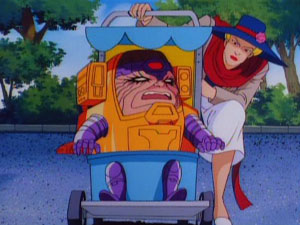
The very first episode of the show highlights perfectly all of the first season’s issues. Just look at the title: And The Sea Shall Give Up Its Dead. That kind of needlessly pretentious writing is just one symptom of a show gone wrong. More importantly, though, this episode introduces no fewer than six heroes, nearly a dozen villains, a dragon, and radioactive zombies (!!!). And it does so in just 22 minutes, including the opening and the closing credits. Plus, MO.D.O.K appears in a baby buggy, Mandarin nearly executes his henchman Blizzard for killing his begonias, and we are introduced to some purely awful CGI. This CGI sequence was used repeatedly in the first season to show Tony donning his armor, and was supposed to look cool; but, well, it never did— even in 1994.
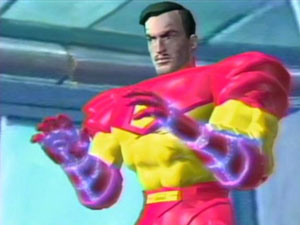
Later episodes fortunately don’t have as many lame humor attempts, but the secondary characters never get fleshed out, Either. Both Iron Man and The Mandarin get origin stories, which is good, but it’s a while before we even hear all of the Force Works members named, with those characters allowed to largely remain as ciphers. We do get to meet Spider-Woman’s daughter in the fourth episode, however, and over time get some familiarity with the rest. For a while, though, I couldn’t figure out who The Scarlet Witch was, but eventually realized that it was the lady in the red swimsuit; not a practical superhero costume!
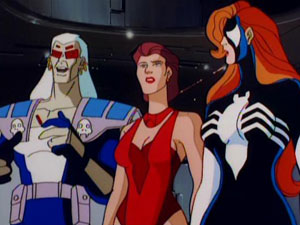
I complained about the over-the-top titles, but do have a soft spot for Rejoice! I Am, Ultimo, Thy Deliverer!, and The Grim Reaper Wears A Teflon Coat. I was less enthusiastic about seeing a story of an Iron Man doppelganger (in the 2-part Iron Man To The Second Power), but perhaps that comes from my disappointment in the big-screen movie’s final act. A story of a kidnapped model (Enemy Without, Enemy Within) serves up some history for M.O.D.O.K., a welcome addition of depth to the show. Overall, the stories generally aren’t really bad, just mediocre. Toss in a suspected betrayal by Hawkeye (The Defection Of Hawkeye), and The Wedding Of Iron Man, and you get a reasonably well-rounded 13-episode season of plots, utilitarian though they may be.
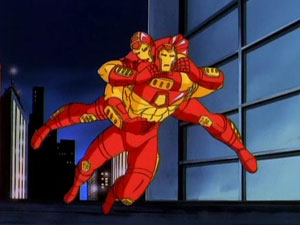
Rainbow Animation Group was the production house that worked on the first season, and their work was sub par. Drawings are sometimes in poor proportion, and animation is jumpy. Characters are often over-designed, following the annoying contemporary comics trend, but this comes off especially poorly in animation. The story editor for this season was Ron Friedman, whose prior credits included scripts for Transformers and G.I. Joe.
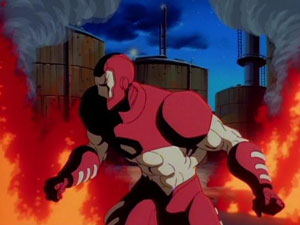
The first season was not as disastrous as it was for its companion Fantastic Four show, but the second season did get a significant facelift. Koko Enterprises took over animation duties, and Greg Johnson (who now works for Marvel Animation) and Tom Tataranowicz (he had worked on a number of the late Filmation shows like He-Man and She-Ra) supervised the stories. This season sees Tony Stark grow longer (blue) hair, the stories adapt then-recent comics storylines like Armor Wars, and the series sees its scope expand.

Tony gains an A.I. helper named H.O.M.E.R. Part of Force Works goes off on its own after Tony fakes his death without telling them in the season opener, The Beast Within, which stays focused on The Mandarin before the season goes in a new direction. S.H.I.E.L.D. and the terrorist outfit A.I.M. enter the picture. Iron Man’s Soviet rival Crimson Dynamo appears in Not Far From The Tree. Beauty Knows No Pain has Madame Masque as a villainess. Hawkeye returns in Iron Man, On The Inside. Mandarin returns, too, which is okay, since by that time we’re no longer tired of him, and for a while he has mostly cameos. A certain giant green monster appears in Hulk Buster, in an episode that ties into the Hulk’s own show (available on a Disney DVD from several years ago). This all ramps up to the two-part series finale Hands Of The Mandarin, which finally sees Iron Man and Force Works attempt to settle things once and for all with their powerful foe.

The second season is a step up from the first, largely due to more focused storytelling, but the leap isn’t as great as it was on Fantastic Four. The animation is definitely more dramatic and accomplished, and the cast is kept thankfully smaller for the most part, but the show still lacks the style and depth of the DC animated shows of the time. Still, it’s a fun show to watch if one keeps one’s expectations in check. After all, it’s hard to beat a tale of an iron-clad adventurer fighting the forces of evil, right?
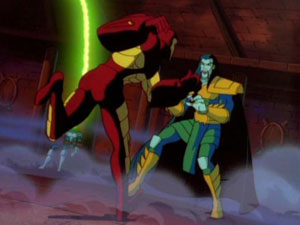
For the record, this version of Iron Man also appeared, complete with this design and the voice of Robert Hays, on a couple of other cartoon shows. As mentioned, he was in an episode of The Incredible Hulk, and also a few episodes of Spider-Man. He did also appear in voiceless cameos on his buddy series Fantastic Four. His next appearance, without Robert Hays, would be in the fairly awful 1999 series Avengers: United They Stand.
Is This Thing Loaded?
There are no bonus features for this DVD set. The first disc does carry Sneak Peeks for The Sorcerer’s Apprentice, When In Rome, Prince Of Persia: The Sands Of Time, and James And The Giant Peach, as well as a Blu-ray promo.
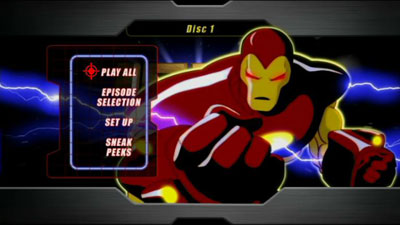
Case Study:
The standard keepcase has a tray that enables it to hold all three discs. The only insert concerns promotion of the Blu-ray format. The foil, embossed slipcover is quite attractive, even if the back cover has only a lame shot of Dreadknight and a promise of seeing Iron Man 2 villain Whiplash, though in the cartoon he was called by his other name, Blacklash.

Ink And Paint:
The image is not especially pretty, with a moderate amount of shimmer present. Detail is pretty shaky, too, with the episodes looking like they came from weak tape copies. Stepping through the episodes frame-by-frame, you can really see the lines and colors shift constantly. It’s a mild mess.

Scratch Tracks:
Stereo sound is available in three flavors: English, French, and Spanish (with subtitles to match). In the era before 5.1 digital television sound or DVD, minimal effort was made to make TV cartoons sound spectacular. The result is noticeably better than mono, but only by degrees.

Final Cut:
The 1994 iteration of Iron Man may not be a classic show, but it does hold some simple thrills for those seeking superhero high adventure. The disparity in quality between the two seasons is not as great as with its companion Fantastic Four show, but the second season certainly does show off a higher degree of polish and maturity. And, when comparing it to the 1960s low-rent version, or the current teenage version of Tony Stark flying around in Iron Man – Armored Adventures, this is probably the closest we ever got to getting a great Iron Man show that kept close to the comics while maintaining some sense of animation quality. It’s faint praise, though, and the shoddy video quality and lack of bonus material makes this release for fans only.
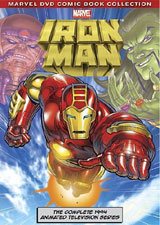 | ||
 |


